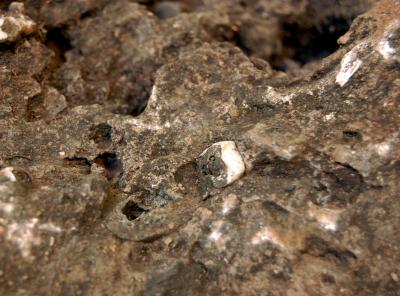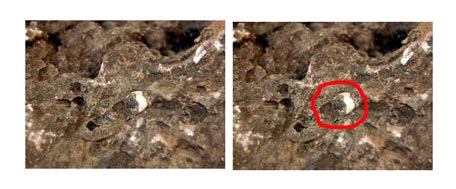Observation is Important in Palaeontology
Can you spot a Fossilised Hominid Tooth?
Observation is very important in science, whether you are looking for the Higgs Boson or simply conducting an experiment with Primary school children to see what happens when you deny some germinating cress seeds access to sunlight. It is important that appropriate observations are made and that these are recorded properly. Observation is key in palaeontology.
When taking a group of young, enthusiastic palaeontologists fossil hunting we demonstrate to them the two main advantages over us “grown ups” when it comes to finding fossils. Firstly, the children being smaller than us are closer to the ground and this is where the fossils can be found. Secondly, as they are younger than us, there us are generally better able to focus on small objects, therefore they can spot fossils better than we can.
Observation is Key in Palaeontology
Most fossils are still found by people who are not palaeontologists, we make a point to emphasis the important discoveries made by children as we enthuse them about the Earth sciences. Observation for a fossil hunter is extremely important. It is not just a case of knowing where to look but also knowing what to look for.
To illustrate this point, let us recall an event that took place recently in a laboratory at the Witwatersrand University in South Africa. The University is a world-leader in early hominid research and has led the way in helping to unravel the evolution of a two million year old hominid species known as Australopithecus sediba.
To read an article on the early hominin A. sediba: New Fossils May Help Define Human Ancestry.
Revision of the Hominin Family
The hominin family tree is constantly being revised as more fossil material is discovered. The Australopithecines were an early group of hominins that evolved around 4.2 million years ago and went extinct around 1.8 million years ago. A number of species have been described, their exact taxonomic relationship to our own species is debated. Researchers at the Witwatersrand University (Johannesburg) had brought back to their preparation laboratory a number of rocks and fossils from a site where A. sediba fossils had been found.
However, for three years a large, one-metre wide rock lay undisturbed in the laboratory until a technician observed a tiny, whitish object sticking out of the matrix. The turned out to be a fossil tooth of Australopithecus sediba and computerised tomography (CT) scans of the rock revealed that hidden inside were a number of fossilised bones of this early hominin. Observation had resulted in the discovery of very rare and important fossil material, in a rock that had been in the laboratory and under people’s noses as it were for years.
Can you spot the tooth in the rock?
Can you spot the Fossilised Tooth in the Rock?
Picture credit: University of Witwatersrand (Johannesburg)
Tooth Spotted in Rock
If the tooth had not been spotted the rock may not have been studied and the chance to learn more about one of the Australopithecines may have been missed. As we say when we are teaching primary school children, the most important tool that a palaeontologist has are his or her eyes. Careful observation can help us to uncover a lot of fascinating information as well as enabling us to spot fossils, even a fossil tooth from a 2-million-year-old, potential ancestor of our own species.
The Tooth Highlighted – Did you Spot It?
Picture credit: University of Witwatersrand with additional input from Everything Dinosaur
For creative palaeontology themed crafts: Educational Dinosaur Themed Crafts and Toys.
Next time you are walking along a beach or wandering past a cutting in the road, take a good look you never know what you might find.
To read the article on the discovery of the fossil material inside the rock: Scientists Discover Amazing Early Human Fossil in Laboratory.



